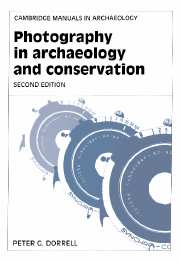Book contents
- Frontmatter
- Contents
- List of illustrations
- Preface
- Preface to the second edition
- Acknowledgements
- 1 The early days of archaeological photography
- 2 Basic principles and practice
- 3 Equipment
- 4 Lighting by flash
- 5 Photographic materials, processing and printing
- 6 Architecture and standing monuments
- 7 Survey photography
- 8 Site photography
- 9 Principles of object photography
- 10 Principles of close-up photography
- 11 Ultra-violet and infra-red photography
- 12 Photographing finds
- 13 Flat copy
- 14 Preparation of material for publication
- 15 The future
- References
- Index
11 - Ultra-violet and infra-red photography
Published online by Cambridge University Press: 23 December 2009
- Frontmatter
- Contents
- List of illustrations
- Preface
- Preface to the second edition
- Acknowledgements
- 1 The early days of archaeological photography
- 2 Basic principles and practice
- 3 Equipment
- 4 Lighting by flash
- 5 Photographic materials, processing and printing
- 6 Architecture and standing monuments
- 7 Survey photography
- 8 Site photography
- 9 Principles of object photography
- 10 Principles of close-up photography
- 11 Ultra-violet and infra-red photography
- 12 Photographing finds
- 13 Flat copy
- 14 Preparation of material for publication
- 15 The future
- References
- Index
Summary
The sensitivity of all silver-based emulsions extends into parts of the electromagnetic spectrum of shorter wavelength than visible light (ultra-violet, UV); and by using specially sensitized emulsions, use can be made of the wavelengths longer than visible light (infra-red, IR).
The UV ranges from about 1 nm (nanometre; one nm = 10−9 m, or one millionth of a millimetre), taken to be the upper limit of the longest X-rays, to about 400 nm, the shortest band of visible light. The UV spectrum is conventionally divided into three or four bands, but for the purposes of photography only two are of importance; the long-wave UV band (also known as Near UV or UVA) from about 320 to 400 nm, and the Middle UV or UVB, from 280 to 320 nm. The peak response of silver emulsions is in the region from 350 to 400 nm, and it is with this band that most UV photography is concerned.
The IR is that part of the spectrum longer than about 700 nm; it merges with microwaves at about 300,000 nm, and beyond that with the radar band. Although images can be formed by means of thermal detectors and image intensifies in the longer IR and beyond, most photography uses the near, or actinic, part of the IR between 700 and 900 nm.
The division between the infra-red, the visible and the ultra-violet parts of the spectrum is of course arbitrary, and one part of the whole spectrum of radiation merges with the next.
Ultra-violet and ultra-violet fluorescence photography
There are two quite distinct ways in which the UV spectrum is used in photography.
- Type
- Chapter
- Information
- Photography in Archaeology and Conservation , pp. 198 - 207Publisher: Cambridge University PressPrint publication year: 1994



